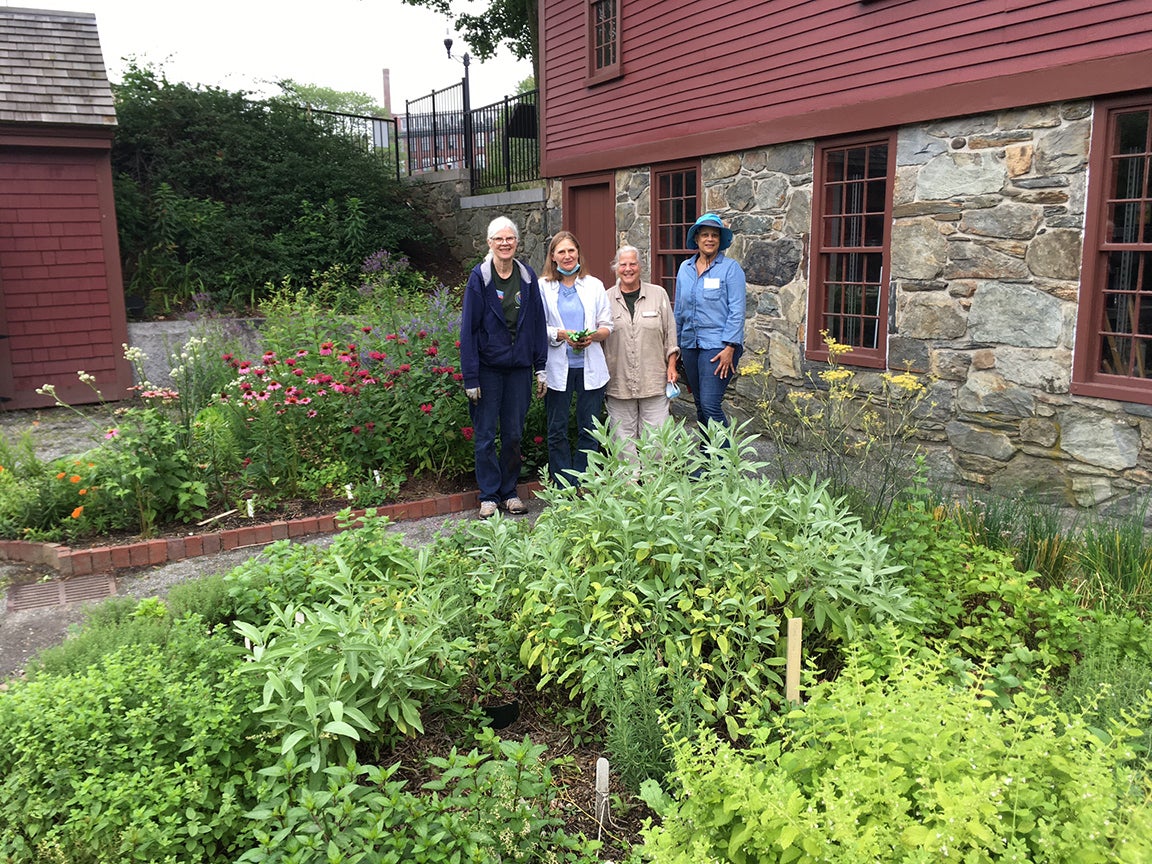PAWTUCKET, R.I. – July 27, 2021 – Woodchucks and rabbits that live around the Slater Mill Historic Site in Pawtucket usually remain well hidden from visitors, but the University of Rhode Island Master Gardeners who assist in maintaining the historic gardens there see evidence of the animals every week. The critters nibble regularly on the heirloom vegetables and cotton plants.
But that hasn’t stopped the team of volunteers from returning twice each week to tend the garden, strategize on how to protect the plants, and enjoy the camaraderie of gardening together.
“I have a relationship with the woodchuck and told him not to touch the herbs, so those are doing well,” joked Sherry Dzamba of Providence, co-leader of the project. “Some of the herbs are varieties that would have been introduced to the colonists by Native Americans. They’re helping us combine the industrial focus of the site with the human history of the area. And they’re natural pest deterrents.”
Slater Mill is a historic textile mill on the banks of the Blackstone River that helped to launch the Industrial Revolution. It opened as a museum in 1955.
The gardens at the site had not been tended for several years when the Master Gardeners were invited to assist with their care in 2015. Initially planted with heirloom vegetables, the current group of gardeners has added a variety of plants representative of the textile industry – white, brown and green cotton, flax for making linen, and numerous flowers and plants that would have been used to make dyes.
“I’ve gardened for a long time, but I wanted to refresh what I thought I knew about gardening, so I took the Master Gardener class in 2011,” said former Pawtucket resident Anne Faulkner, the project’s other leader. “I’m really interested in history, especially food history, so working on the heirloom garden was of interest to me. And now I’ve gotten interested in dye plants and fiber plants.”
Other volunteers, like Linda Bausserman of Greenville and Susan Rezendes of Pawtucket, joined the project in part to learn more about the dye, fiber and medicinal plants at the site and to share their new knowledge with visitors. “Many of the plants seem so unusual compared to what I’m used to,” said Bausserman, who previously volunteered at the Roger Williams Park Produce Garden in Providence.
“I wanted to see how people lived hundreds of years ago and see how we might incorporate those practices today,” added Rezendes. “I also like getting my hands in the soil. It allows me to connect with nature.”
This year the National Park Service has taken over the Slater Mill Historic Site to incorporate it more fully into the Blackstone River Valley National Historic Park. The Master Gardeners are hopeful that conversations with the rangers and interpreters will yield new ideas about how the garden can be incorporated into the site’s educational programming and public tours.
“The National Park Service is excited to work with community stewards such as the URI Master Gardeners at Old Slater Mill to protect this priceless historic resource and teach our visitors about Pawtucket’s amazing history,” said Andrew Schnetzer, a ranger at the park.
In the meantime, the gardeners will continue to look forward to their twice-weekly visits to tend the plants and fend off the wildlife.
“It’s a peaceful place to spend time,” said Dzamba. “It’s a nice place to garden in the middle of all the concrete of the city.”
The Slater Mill garden is one of more than two dozen community garden projects that URI Master Gardeners tend to educate citizens about environmentally-sound gardening practices and to provide food for those in need. To learn more about the URI Master Gardener program, visit web.uri.edu/mastergardener.

